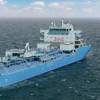Transition to a Hydrogen Future Has Begun
There is a growing international consensus that clean hydrogen will play a key role in the world’s transition to a sustainable energy future, said Noé van Hulst, who chairs the High-Level Advisory Panel for the International Energy Agency (IEA)’s forthcoming hydrogen study.
Hulst, the Hydrogen Envoy for the Ministry of Economic Affairs & Climate Policy, The Netherlands, said that it is crucial to help reduce carbon emissions from industry and heavy transport, and also to provide long-term energy storage at scale.
Hydrogen is a versatile energy carrier that can be produced from a wide range of sources and used in many ways across the entire energy sector. It could become a game-changer in its low-carbon form, but its widespread adoption faces challenges, Hulst, a former Chair of the IEA Governing Board (2017-2018) said.
The International Energy Agency is preparing a major new study to assess the state of play for hydrogen, its economics and potential. Due to be published in mid-June, the report will be a key contribution to Japan’s 2019 Presidency of the G20.
Researchers have found that clean hydrogen still costs too much to enable it to be widely deployed. Prices may not come down sufficiently until the 2030s, according to some estimates. But despite the uncertainty surrounding the future of clean hydrogen, there are promising signs that it could become more affordable sooner than expected.
Where the hydrogen comes from is important. At the moment, it’s mainly produced industrially from natural gas, which generates significant carbon emissions. That type is known as “grey” hydrogen.
A cleaner version is “blue” hydrogen, for which the carbon emissions are captured and stored, or reused. The cleanest one of all is “green” hydrogen, which is generated by renewable energy sources without producing carbon emissions in the first place.
Green hydrogen can in principle be shipped around the world to places that are less well endowed with cheap renewable energy sources.
Japan has several important pilot projects underway – with countries including Australia, Saudi Arabia and Brunei – to determine the best way to transport green or blue hydrogen over large distances by ship.
Energy policy can clearly make a big difference through measures such as minimum CO2 prices. Another important factor is the way in which the authorities can foster the energy transition.
The Dutch government has announced the broadening of its low-carbon program. At the moment, it’s restricted to subsidies for producing renewable energy, but it will soon be expanded to include all possible cost-effective ways to reduce CO2, including CCUS. This will help the market-driven activation of blue hydrogen projects and, depending on how costs evolve, hopefully that of green hydrogen projects in the near future.













